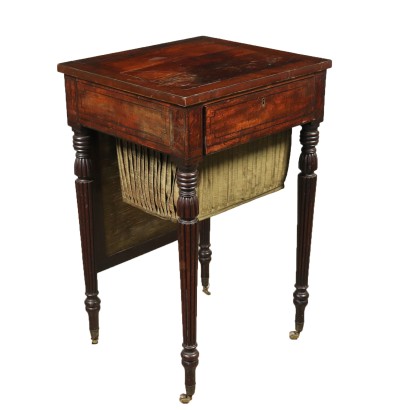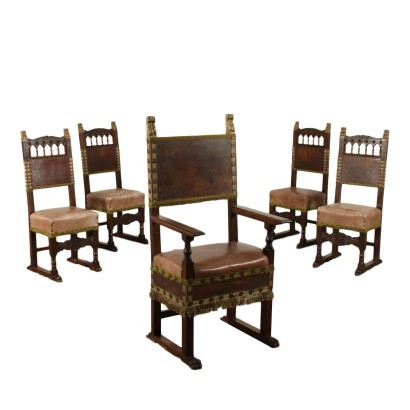Elegant Coffee Table with Secret Drawers England 19th Century
Features
Age: 19th Century / 1801 - 1900
Origin: England
Main essence: Ebony , Mahogany , Rosewood
Material: Mahogany Feather Banded
Description
An elegant coffee table with turned and fluted legs with brass castors. Sliding panel on the back side with fabric holder for laces. On the side, a pull-out fabric drawer-compartment for balls of wool. A drawer with reclining top and fabric insert on the front side. Further small drawer for pins on the side. Top with rosewood reserve and ebony outlines. Manufactured in England, second quarter of the 19th century.
Product Condition:
Fair condition. Wear consistent with age and use.
Dimensions (cm):
Height: 80
Width: 51
Depth: 46
Additional Information
Age: 19th Century / 1801 - 1900
19th Century / 1801 - 1900 Main essence:
Ebony
Without any doubt it is one of the most precious and appreciated essences ever. Very hard and resistant, it is pleasant to the touch thanks to its smoothness, it is a wood with a typical black color. Being very rare it was traded as a precious metal and frequently forged. Because of its hardness, it is very difficult to work, which is why the term cabinetmaker, which indicates the very skilled craftsman in fine carpentry works, derives from this very essence. In modern times, it was introduced by the Flemings and Germans and immediately enjoyed success with the French. The golden period for Ebony was the Baroque, especially in the Boulle style workings. In general it is widely used in inlays, but also for furniture upholstery, for contrasting effects alongside brass, bronze and tortoiseshell.
Mahogany
It is one of the most precious and sought-after woods in cabinet making. It was discovered in Central America around 1600 and began to be imported to England in the 1700s. Much appreciated for its hardness and indestructibility, it became widespread following the blocking of walnut exports from France in 1720 and the consequent elimination of English import duties on mahogany from the colonies in America and India. The most valuable version comes from Cuba, but it became very expensive. At the end of the 18th century it began to be used also in France in Louis XVI, Directory and Empire furniture, its diffusion declined starting from when Napoleon, in 1810, forbade its import. It was generally used in the manufacture of elegant furniture, due to its characteristics and beautiful grain.
Rosewood
Under the term Rosewood various exotic, hard and heavy woods have been united, characterized by a color that varies from pink to violet. Their origin is usually from Latin America, India and Africa and are still considered very valuable woods. Until the end of the eighteenth century, this name also referred to the bois de violette . In general, rosewood woods began to be imported into Europe starting in 1750 and were first used for veneers and inlays in England, flanked, by contrast, with lighter woods. Later, entire valuable furniture was manufactured both in England, mainly in the Regency style, and in France, starting from the Neoclassical period.
Material: Mahogany Feather Banded


























